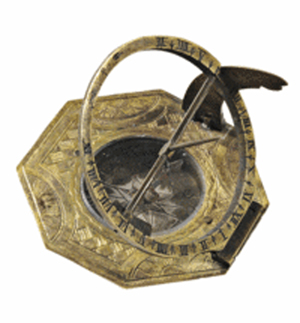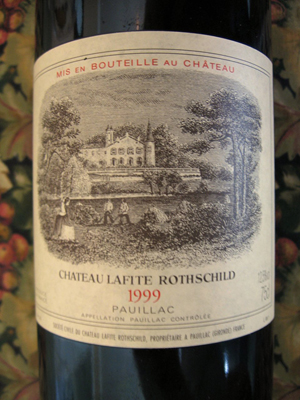
Sundials are not just garden ornaments. They can tell time if set up properly. They have been made for centuries and collectors search for the flat type called “equatorial” or “equinoctial” sundials by experts, and other types like those made to hang on a wall or those that are spherical or cone-shaped. The age, maker, shape and decoration all determine the price. Usually 17th- and 18th-century signed brass sundials are best. There are two important parts to a sundial. The “plate,” which usually is a round, flat disk marked with numbers, and the “gnomon,” the piece that casts the shadow on the plate. Most modern sundials come with directions for installation. It is determined by the latitude, the North Star and some adjustments to find due north. There are websites that list complete directions. Many sundials sold in gift shops today make no attempt to be used as anything but ornaments and cannot be set accurately. A very small handheld sundial made in the mid-18th century by Andreas Volger of Augsburg,Germany, was auctioned in 2010 by Skinner’s in Boston. It has an octagonal base and engraved Roman numerals, Latin words and city names. It sold for $450. Look for garden antiques that can stay outside, like a large brass sundial, but wipe the brass with a thin coating of wax for added protection from snow and rain.
Q: I have read about dangerous jugs made of radioactive clay. I collect stoneware jugs. What should I worry about?
A: When radium was discovered, many thought it had curative qualities. So some quack medicine potions and medical devices were made using radium. One of the most popular and the one most often a problem today is the “Revigorator” jug. Although it was made in the 19th century, it is shaped like an atomic energy plant cooling tower. There is a spigot near the bottom of the jug and printed information on the sides. The jug was made with radioactive material, and even today the jugs are radioactive. They should be tested with a Geiger counter if kept on display. The inside is more dangerous than the outside, so do not put your hand inside the jug. And although the instructions say to fill the jug with water you can drink, that’s a danger to your health. It probably wise not to display a Revigorator. To dispose of it, ask how your city handles toxic waste. Other jugs and bottles may contain remnants of dangerous poisons, so be careful about leaving them open or even saving the contents.
Q: I collect stuffed-cloth advertising dolls. What are the most important dolls to look for?
A: Every collector has favorites. I like the early Aunt Jemima family of four, Kellogg’s Rice Krispies Snap, Crackle and Pop and Goldilocks and the Three Bears, Campbell Soup’s Campbell Kids and the Pillsbury Doughboy. More recent dolls include those made for fast-food restaurants, like McDonald’s Ronald McDonald and Hamburgler, and Burger King’s King.
Q: When was fake bamboo furniture popular? I have a dresser that has drawer edges made of wooden dowels painted to look like bamboo. Round, carved and painted, bamboo-shaped posts at the edges serve as trim and feet.
A: Everything Asian, especially Japanese, was considered elegant, mysterious and high-fashion in the days of the Aesthetic Movement, from the 1870s to 1900. In Britain, bamboo and faux-bamboo furniture was popular for summer homes. The idea spread to the United States, and R.J. Horner Co. of New York City was the best-known of the furniture makers that popularized the style. The U.S. Centennial in 1876 mounted some Japanese exhibits that sent American designers of pottery, furniture and other decorative arts in a new direction. The American furniture on display was made of wooden faux bamboo because these pieces were stronger and would last longer than anything made with real bamboo. In Britain, real bamboo often was used. Today, 19th-century bamboo pieces are again popular and more difficult to find, but they’re still priced lower than top-quality new furniture.
Q: When I was married in 1952, I picked out Hallcraft dinnerware in the Bouquet pattern by Eva Zeisel. I’m now 91 years old. The store I bought the set from is not in existence anymore. I’m wondering if the dishes have any value. They were used only two or three times.
A: Eva Zeisel has designed products for many different companies in the United States and Europe. Her pieces are sought by collectors around the world. She was born in Budapest, Hungary, in 1906, and moved to the United States in 1938. She designed dinnerware patterns on two shapes under the Hallcraft label for Hall China Co. Bouquet was designed in 1952 on the Tomorrow’s Classic shape, which featured some innovative serving pieces in unusual shapes. A Bouquet bread-and-butter plate sold for 65 cents in 1952, and sells for $7.99 today. A 71-inch platter that originally sold for $3.70 sells for $55.99 today. Salt-and-pepper shakers that sold for $1.05 each sell today for $69.95 a pair. It is an easy pattern to sell, but you should use your china and enjoy the pretty pattern. What are you waiting for?
Take advantage of a free listing for your group to announce events or to find antique shows and other events. Go to Kovels.com/calendar to find and plan your antiquing trips.
Terry Kovel answers as many questions as possible through the column. By sending a letter with a question, you give full permission for use in the column or any other Kovel forum. Names, addresses or email addresses will not be published. We cannot guarantee the return of any photograph, but if a stamped envelope is included, we will try. The volume of mail makes personal answers or appraisals impossible. Write to Kovels, Auction Central News, King Features Syndicate, 300 W. 57th St., New York, NY 10019.
CURRENT PRICES
Current prices are recorded from antiques shows, flea markets, sales and auctions throughout the United States. Prices vary in different locations because of local economic conditions.
Ward’s Bakelite Airline Radio, white case, dial centered above two knobs on right side, speaker on left, 1947, $30.
Pajama bag doll, painted oilcloth head, stuffed head and dangling legs, bobbed 1920s hairstyle, 1920s-’30s, 31 inches, $65.
Mr. Herbert couture high heels, bright red, 1950s, 3-inch heels, size 7, $125.
Silver-plated Victorian water pitcher, metal, porcelain liner, finial is sea nymph sitting on fish, hinged lid, ice lip, marked “Meriden ES” and “Patented July 9, 1872,” 13 inches, $145.
Cast-iron curtain tie-backs, pastel pink dogwood flowers, 1920s, 2 1/2 x 2 7/8 inches, pair, $225.
American Can Co. ruler, tin lithograph, “Cans, Fine Metal Boxes, Lithographed Metal Ware,” image of 1904 St. Louis World’s Fairgrounds, 3 3/4 x 9 1/2 inches, $305.
Cast-iron Buster Brown and Tige still bank, original paint, A.C. Willams Co., 1910-’19, 5 1/2 inches, $400.
Lady’s neoclassical secretary-bookcase, mahogany, two parts, double cornice, two glazed doors, 12 panes, fold-over writing surface, two lower drawers, scrolled front feet, 1825-30, 72 x 41 inches, $470.
Rookwood high-glaze lamp base, white-and-yellow narcissus on blue ground, signed, “Shirayamadani,” 1945, 13 inches, $940.
Wurlitzer jukebox, Model 1100, walnut case, rotating color wheels, large window, plays 24 selections, 78-rpm records, 1940s, 57 1/2 x 30 x 26 inches, $2,355.
Available now! The best book to own if you want to buy or sell or collect—and if you order now, you’ll receive a copy with the author’s autograph. The new Kovels’ Antiques & Collectibles Price Guide, 2012, 44th edition, is your most accurate source for current prices. This large-size paperback has more than 2,500 color photographs and 40,000 up-to-date prices for more than 775 categories of antiques and collectibles. You’ll also find hundreds of factory histories and marks, a report on the record prices of the year, plus helpful sidebars and tips about buying, selling, collecting and preserving your treasures. Available online at Kovelsonlinestore.com; by phone at 800-303-1996; at your bookstore; or send $27.95 plus $4.95 postage to Price Book, P.O. Box 22900, Beachwood, OH 44122.
© 2011 by Cowles Syndicate Inc.


